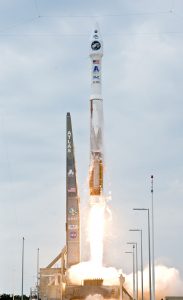 Have you heard of the Atlas V? It’s the fifth version of Boeing’s expendable rocket-based launch system. The first Atlas V flight was conducted in 2002, with the most recent flight occurring in 2021. Even if you’re familiar with the name, though, there are probably some things about the Atlas V that you don’t know. This post reveals five surprising facts about the Atlas V.
Have you heard of the Atlas V? It’s the fifth version of Boeing’s expendable rocket-based launch system. The first Atlas V flight was conducted in 2002, with the most recent flight occurring in 2021. Even if you’re familiar with the name, though, there are probably some things about the Atlas V that you don’t know. This post reveals five surprising facts about the Atlas V.
#1) Originally Designed By Lockheed Martin
The Atlas V was originally designed by Lockheed Martin. Lockheed Martin was tasked with designing the Atlas V on behalf of the U.S. Air Force. The U.S. Air Force created the Evolved Expendable Launch Vehicle (EELV) program, which Lockheed Martin participated in. The Atlas V project is now a joint effort between Lockheed Martin and Boeing.
#2) 2 Stages
The Atlas V consists of two stages. The first stage consists of an RD-180 engine that runs on a mixture of kerosene and liquid oxygen. The second stage consists of an RL10 engine that runs on liquid hydrogen and liquid oxygen. Like with other dual-stage lunch systems, the Atlas V will engage its first stage, followed by its second stage. Boeing and Lockheed Marting have modified the stages of the Atlas V since its initial design. Nonetheless, the Atlas V still consists of two stages.
#3) NASA Contracts
The National Aeronautics and Space Administration (NASA) has already agreed to use the Atlas V to send astronauts to the International Space Station (ISS). In 2011, Boeing revealed that it had secured a contract with NASA to send astronauts to the ISS. For the mission, the Atlas V will be used as the launch system for Boeing’s crew capsule, the CST-100.
#4) Amazon Contracts
NASA isn’t the only customer of Boeing’s Atlas V. Amazon has agreed to use Boeing’s dual-stage launch system as well. Unbeknownst to many of its customers, Amazon is developing a high-speed internet service. Known as Project Kuiper, it consists of a network of small, low-orbiting satellites that beam an internet connection down to Earth. For its Project Kuiper, Amazon signed a contract with Boeing for nine Atlas V launches.
#5) 100% Mission Success Rate
The Atlas V has achieved an impressive 100% mission success rate. Since its initial launch in 2002, it has successfully completed all of its missions. Most launch systems, of course, have a lower success rate, with many of them ranging from 80% to 90%. The 100% mission success rate of the Atlas V is a testament to its high-quality design and stringent testing requirements.



